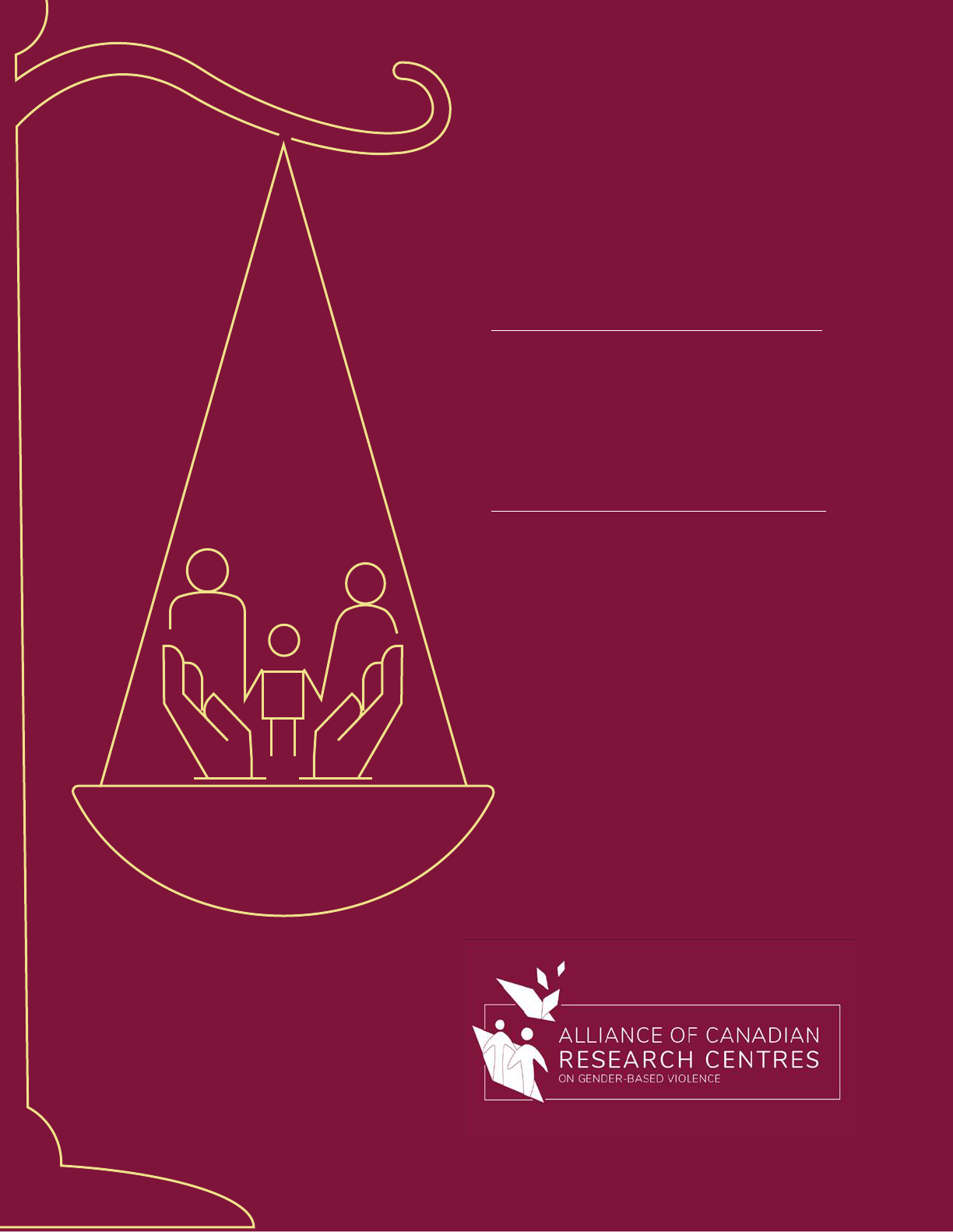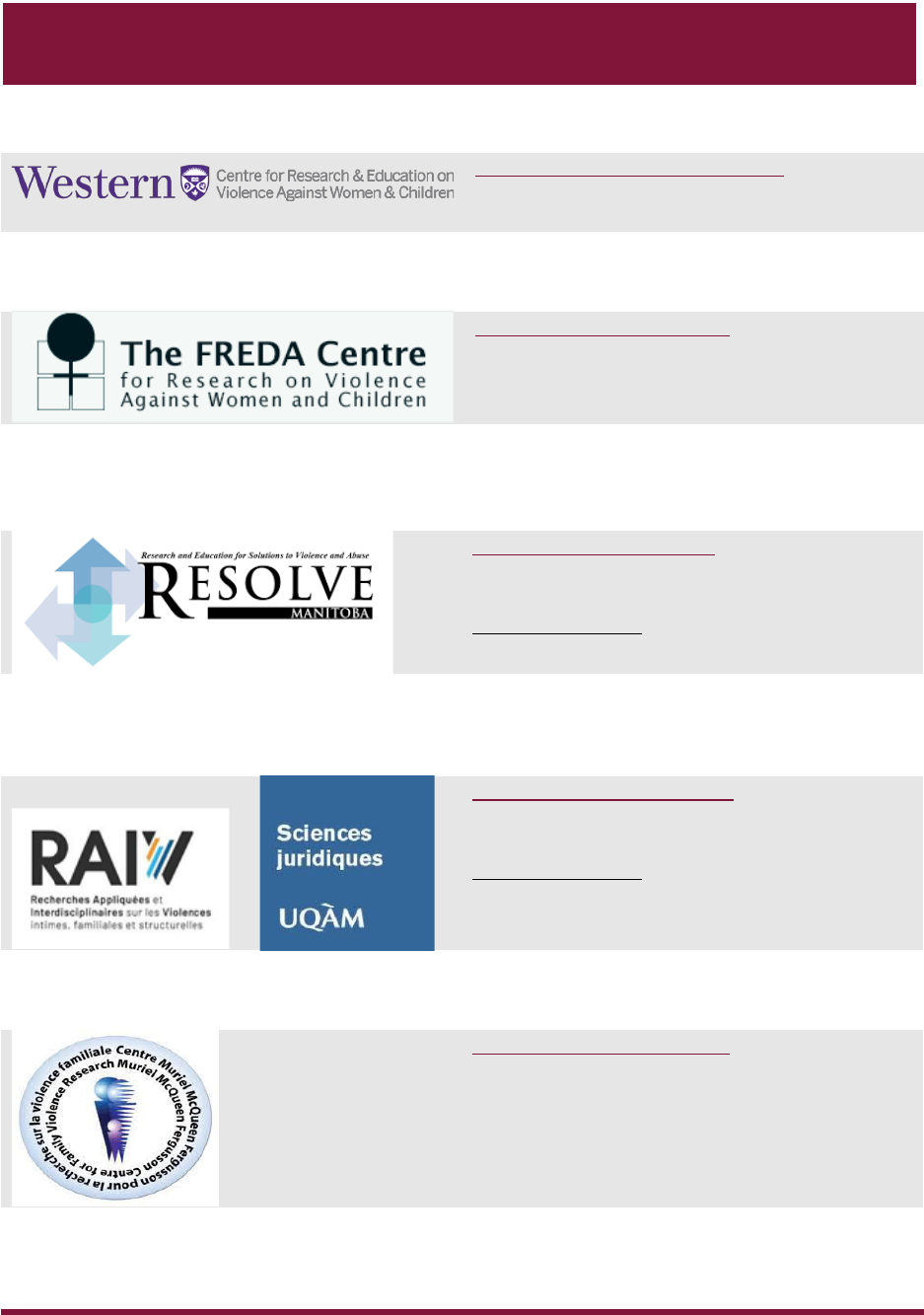
Family Violence & Family Law Brief (17) | alliancevaw.ca
1
Family Violence &
Family Law Brief
Family Violence and
Family Law: Ethical
Obligations of Family Law
Practitioners
Issue 1 | October 20228

This Brief was prepared by Daphnée B. Ménard, Katja
Smedslund, Dominique Bernier and Geneviève Lessard for the RAIV
(Recherches appliquées, interdisciplinaires sur les violences intimes,
familiales et structurelles) in partnership with Université du
Québec à Montréal (UQAM) on behalf of the Alliance of Canadian
Research Centres on Gender-Based Violence.
RAIV is based at the Pavilion Charles-De Koninck, Université
Laval, Québec, Québec, Canada, on the unceded territories of the
Wyandot Peoples.
UQAM is based at Montreal/Tiohtià:ke, Québec, Canada, on lands
that are part of an ancestral territory that has long served as a place of
life, meetings, and exchanges between Indigenous peoples, in
particular the Mohawk/Kanien’kehá:ka nation.
Suggested Citation
B. Ménard, Daphnée; Smedslund, Katja; Bernier, Dominique et Lessard,
Geneviève. (2021). Family Violence and Family Law: Ethical Obligations
of Family Law Practitioners. Family Violence & Family Law Brief (18).
Québec, Québec: Recherches appliquées, interdisciplinaires sur la
violence intime, familiale et structurelle. ISBN: 978-2-925194-05-7
Design
Daphnée B. Ménard, based on Natalia Hidalgo, Communications
Coordinator at the Centre for Research & Education on Violence Against
Women & Children
Translation
Kathryn Lawson
Share Your Feedback on This Brief
Click the following link to share feedback about this Brief or suggestions
about future resources:
https://uwo.eu.qualtrics.com/jfe/form/SV_bQPgoQ57z58PpC6
Join us
Email us if you would like to receive information about future resources
and webinars: crevawc@uwo.ca

Family Violence & Family Law Brief (18) | fvfl-vfdf.ca
3
Family Violence and Family Law: Ethical
Obligations of Family Law Practitioners
A number of Canadian jurisdictions recently amended their family law statutes to include a definition of
domestic or family violence (we will primarily use the term “family violence” hereafter “FV”). Canada’s
Divorce Act and British Columbia’s Family Law Act are two examples. The Divorce Act was amended to
introduce measures to assist the courts in addressing FV. Henceforth, courts are required to consider any
family violence and its impacts when deciding the best interests of the child (s. 16(3)(j)).
While these new provisions are crucial to helping FV victims, the Divorce Act does not clearly stipulate that
lawyers must be trained in FV or that they must systematically screen for FV when taking on a new case.
This raises the following questions: Are legal practitioners capable of identifying situations in which these
provisions could be applied? Do they have the qualifications and training needed to handle FV cases?
FV is an important factor in family law cases. When FV is present, legal expertise in the matter is
fundamental to identifying all of the family law issues that need to be addressed, the support services a
client might need and the means of promoting the safety of the client and her children throughout the
judicial process.
Note that separation is one of the two risk factors associated with intrafamilial homicide that have been
the most clearly established in the scientific literature, the other being a history of FV (Coroner, 2020). In
the context of separation, women are more likely to be the victim of domestic homicide or serious injury.
According to the report on FV-related deaths released by the Quebec coroner’s office, eight of the ten
incidents reviewed involved a separation or divorce. More specifically, four of the incidents involved a
dispute regarding child custody or visitation rights (Coroner, 2020). During a separation or divorce, the
partners are likely to deal with family law advocates, notaries, mediators and judges in order to resolve any
potential conflict, particularly with regard to parenting time. Consequently, legal practitioners are key
players and their ability to recognize potential FV situations and the associated risk factors is of major
importance for improving the safety net for FV victims and preventing FV-related deaths. Moreover, one of
the recommendations in the Domestic Violence Death Review Committee’s report consists in raising
awareness among family law practitioners and providing them with training in FV. The committee also
recommended educating and training law students in FV, placing emphasis on the roles family law
practitioners can play in detecting and preventing FV (Coroner, 2020).
This brief discusses the rules of conduct for legal practitioners involved in FV cases. The first part sets out
the ethical obligations of lawyers, notaries, family mediators and judges in Quebec. The second part
examines current practices of family law judges and lawyers as well as issues surrounding errors of law and
ethical misconduct. The last part looks at the best practices for handling FV cases.
Part I – Ethical Obligations of Lawyers, Notaries, Family
Mediators and Judges in Quebec: Competence, Training
and Screening for FV
Part I provides an overview of the ethical obligations of the primary professionals involved in the justice
system with respect to competence, training and screening for FV.

Family Violence & Family Law Brief (18) | fvfl-vfdf.ca
4
a. Lawyers
The Code of Professional Conduct of Lawyers stipulates that lawyers must act at all times in the best
interests of their client(s) (s. 23). In addition, they owe the client duties of competence (s. 20) and must
provide quality services (s. 22). Lawyers must engage in their professional activities with competence and,
to that end, must develop their knowledge and skills and keep them up to date (s. 21). For that purpose,
lawyers have a duty of continuing professional development: they are required to complete at least 30
hours of approved training during each 2-year reference period, including 3 hours from a list of activities
that address ethics, professional conduct or professional practice.
More specifically, before accepting or pursuing a mandate, a lawyer must bear in mind any limits to their
skills in light of the area of law involved or the nature of the professional activities required, the time
available for carrying out the mandate and the possibility of collaborating with another person. If the lawyer
believes such limits will jeopardize the quality of their services or the proper protection of the client’s
interests, they must so notify the client and advise the client about the conditions for the performance of
the mandate so the client can make an informed decision. A lawyer who, with the consent of the client,
undertakes or pursues a mandate notwithstanding the limits identified must take reasonable means to
obtain the necessary assistance for its performance (s. 29). A lawyer must cease to act for a client if the
lawyer determines that they do not have the competence required to continue to perform the mandate (s.
49).
In Quebec, family law lawyers are under no professional obligation to either receive FV training or
systematically screen their clients for FV.
However, the recent report by the Expert Committee on Support for Victims of Sexual Assault and Domestic
Violence recommended creating a bank of sexual assault and FV lawyers in private practice who should
receive relevant and lifelong training in such matters (Desrosiers and Corte, 2020). This led to the recent
creation of a bank of Quebec lawyers specialized in sexual and family violence. Anyone who wants to be
represented by a lawyer, especially a family lawyer in private practice, trained in and aware of the realities
of victims and survivors and prepared to inform, advise, assist or represent them can access the bank. The
legal practitioners registered in the bank have received free, general training in FV, funded by the Ministère
de la Justice du Québec and available to legal practitioners and other professionals interested in developing
know-how and strategies for better intake and support of victims in legal proceedings.
b. Notaries
In Quebec, notaries can also help separating couples navigate various steps, from support payments and
child custody to the separation agreement. Under certain conditions, a notary can also represent the
partners in court.
The Code of ethics of notaries requires every notary to consistently strive to maintain up-to-date knowledge
of their profession. A notary must always remain informed of developments in the areas in which they
practise and must maintain their skills in these areas (s. 5). However, like lawyers, notaries have no specific
ethical obligation to obtain training in FV or to screen their clients for FV.

Family Violence & Family Law Brief (18) | fvfl-vfdf.ca
5
c. Family mediators
In Quebec, family mediators include lawyers, notaries, social workers, couple therapists, psychologists,
psychoeducators and guidance counsellors. All of them are required to comply with their respective code of
professional conduct and best practices.
Since the codes of professional conduct of the different groups involved do not necessarily include specific
rules concerning family mediation practice, the Comité des organismes accréditeurs en médiation familiale
(COAMF) deemed it necessary to establish common standards of practice to ensure high standards of
practice as well as harmonization in the quality of family mediation practices in Quebec. They can be found
in the guide entitled Standards of Practice in Family Mediation. Note that these standards do not have the
force of law; rather, they constitute a type of self-regulation specific to this field.
What is particularly interesting about the guide is that it includes an entire section on domestic violence
(DV, Section 5) and the duties and obligations of family mediators in a situation of DV. Ensuring the
psychological and physical well-being of their clients represents the guiding principle of the family
mediator’s approach in a DV context (5.2.1). In addition, it is the duty of all mediators to act competently
while taking into account the particular issues within the context of DV (5.2.2):
In the context of domestic violence, the mediator’s competency includes the ability
to identify the problem and the appropriate intervention. The mediator may also suspend
or terminate the mediation process if there is persistent domestic violence and the abuser
or the abused person is unable to negotiate respectfully face to face.
As specifically regards screening, the guide provides that:
5.3.1 The family mediator needs to understand two appropriate tools/techniques for
recognizing domestic violence and distinguishing it from strategies couples use in fighting.
5.3.2 In each new family mediation, the family mediator must use the means that he deems
pertinent to differentiate the type of dynamic to which he is confronted. That is;
circumstantial conflict, the dynamics of high level conflict and finally domestic violence.
5.3.3 This evaluation is made continuously throughout the family mediation process.
Furthermore, the Regulation respecting family mediation, which sets out the conditions for certification,
supervision and the fees payable by the government for family mediation services, requires that family
mediators be certified, which involves taking a basic training course in family mediation that includes at
least 6 hours to promote awareness regarding domestic violence, particularly spousal abuse (s. 2(4)).
Quebec’s Code of Civil Procedure stipulates that individuals who provide a certificate confirming that they
have gone to a victims assistance organization recognized by the Minister of Justice for help as a person
who is a victim of FV are exempted from participating in a mandatory mediation information session (s.
417).

Family Violence & Family Law Brief (18) | fvfl-vfdf.ca
6
d. Judges
Under the Judicial code of ethics and the Code of ethics for municipal judges of Québec, a judge has a duty
to foster his professional competence (s. 3) and should be, and be seen to be, impartial and objective (s.
5). The judge should also uphold the integrity and defend the independence of the judiciary, in the best
interest of justice and society (s. 10).
A recent statutory amendment introduced the requirement for judges to take a professional development
program on the realities relating to sexual and domestic violence (s. 257, Courts of Justice Act). On
November 26, 2021, the National Assembly of Québec passed Bill 92, An Act to create a court specialized
in sexual violence and domestic violence. The Act provides that any person who is a candidate for the
office of judge (municipal, court of justice or justice of the peace), must undertake to complete, if
appointed, the professional development program on the realities relating to sexual violence and
domestic violence established by the Conseil de la magistrature. Although the newly established Division
Specialized in Sexual Violence and Domestic Violence is part of the Criminal and Penal Division of the
Court of Québec, the requirement to complete the professional development program applies to any
person who is a candidate for the office of judge and not solely to Criminal and Penal Division and/or
Specialized Division judges. Note that the Act provides for continuing education on the realities relating
to sexual violence and domestic violence for persons who may intervene within the specialized court,
in particular defence attorneys, prosecutors, clerks, investigators, police officers, court personnel,
interpreters and psychosocial workers. Unfortunately, since this concerns only individuals who may
intervene within the specialized division of the Criminal and Penal Division, the new Act does not apply to
lawyers and other family law practitioners.
Given the increase in the number of litigants acting alone before the courts, especially family courts
(Bernheim et al, 2021), equipping judges with the skills and training to handle FV cases is all the more
important considering that a judge is one of the only people in a position to detect FV, even if the judge is
not officially required to systematically screen for FV in every litigant whose case they hear. However, in
the context of family-related litigation, the court may, at any time, stay the proceeding or adjourn the trial
to enable the parties to enter into or continue mediation. Before making such a decision, the court
considers such factors as whether there is an equal balance of power between the parties and whether
there have been incidents of FV (art. 420 C.C.P).
In sum, lawyers and notaries have only general duties of competence and training, whereas judges are
henceforth required to complete training relating to sexual violence and FV. Family mediators are already
required to take a training course in the realities of FV in order to be certified and, even if they are just
guidelines, the Standards of Practice in Family Mediation are still the most concrete and specific standards
for detecting FV and steering an FV case.
Part II – Current Training and Screening Practices
Part II presents some Canadian statistics relating to the current practices of family lawyers and family
court judges in FV matters. This will allow us to look at errors in law and ethical misconduct, primarily in
relation to popular mythology and stereotypes about FV and victims of FV.

Family Violence & Family Law Brief (18) | fvfl-vfdf.ca
7
a. Studies on current practices in Canada: insufficient
education and screening
In 2016, a national survey of family law lawyers and judges (Bertrand et al, 2016) was conducted to gain a
better understanding of the practice of family law in Canada. According to the survey findings:
• Over two-thirds of lawyers (69.0%) said that they often or almost always screen for FV, compared to
almost one-half (46.9%) of judges.
• Over one-half of lawyers (53.1%) said that they never use a standardized measure or instrument to
screen for family violence, and another 25.5% said that they rarely do so.
• On average, lawyers reported that family violence is an issue in 21.7% of their cases and judges said
that it is an issue in 25.3% of their cases.
• The most common responses for how the courts addressed family violence often or almost
always were by
→ making a civil order restraining harassment or regulating contact between the parents (lawyers =
54.7%; judges = 71.0%),
→ denying custody to the abusive parent (lawyers = 38.7% judges = 50.0%), and
→ ordering access supervision (lawyers = 36.2%; judges = 54.6%).
A recent report deals specifically with how FV is addressed in the family law system in British Columbia
(Hrymak and Hawkins, 2021). Part of the research project consisted in surveying family law lawyers to
understand their experiences with using the Family Law Act, particularly the extent to which the inclusion
of a specific consideration of FV impacted their practice. The survey asked family law lawyers whether they
had received any family violence education and, of the 18 respondents, 8 indicated no.
The findings indicate a lack of FV education for family law lawyers and judges as well as systematic
screening for FV using a standard tool. But beyond skills needed to identify FV, the study also found that
family law lawyers lack the skills to properly assist victims of FV in navigating the family court system. In
fact, focus groups and interviews with women who had experienced FV and accessed the family court
system were also conducted. Among other things, they were asked about their experiences with their
lawyer:
Many women recounted positive experiences they had working with their lawyers. Positive
experiences included: feeling like they could communicate with their lawyer, the lawyer
displaying compassion and a willingness to help, and feeling that their lawyer was “on their
side.” Unfortunately, many more women spoke of negative experiences they had with their
lawyers. Negative experiences that were recounted most frequently were: feeling rushed by
their lawyer; not being taken seriously; and that their lawyer was not a safe person to
disclose to because the lawyer did not understand their experiences. (our emphasis)
The report also underscores the importance of educating actors within the family law system, particularly
so as to deconstruct myths and biases about women who have experienced FV. The report’s authors point
out that women’s experiences of violence are often discredited by the legal system owing to prevailing
myths and stereotypes. Ultimately, this puts women at greater risk of future violence. The report (Hrymak
and Hawkins, 2021, pp. 46-47) denounces the following myths and stereotypes: women exaggerate
violence against them; women don’t want dads to see their kids because they are vindictive; if women are
experiencing violence, they will report it to police and the police will respond appropriately; and women are
just trying to get more money and property from their ex-partner.

Family Violence & Family Law Brief (18) | fvfl-vfdf.ca
8
In a legal context, reasoning based on the above myths and stereotypes is faulty reasoning. We submit that
such reasoning should constitute ethical misconduct.
b. Myths and stereotypes associated with FV victims: error in
law and possible ethical misconduct
A recent decision by the Court of Appeal of Quebec (J.L. c. R., 2021 QCCA 1509) addressing
criminal harassment in an FV case referred to the rule against stereotypical inferences based on an
analysis of Canadian case law in the matter. The Court of Appeal found that the trial judge erred in law by
relying on conjectural reasoning and stereotypes about how FV victims are expected to act, which
materially affected the analysis of evidence and the acquittals:
[Translation]
[81] The judge found that the majority of the acts committed against F... A... took place
before she moved in with the appellant. Therefore, she could not have felt harassed,
because she moved in with him knowing that he was controlling and manipulative and, what
is more, she didn’t close the door on getting back together after they separated. He
concluded that the plaintiff was not afraid of the appellant because she sent him text
messages and, in addition, she allowed access to her location at any time “to avoid another
fight, anger.”
47
The appellant “didn’t deny that he was the one who installed the geolocation
app on the cell phone.”
48
[82] The prosecution argued that such reasoning relied on stereotypes, the idea that an
“expected” or a “normal” victim should have refused, protested or shown fear.
[83] In my opinion, the prosecution was right. The judge used stereotypes that follow the
same logic as those the Supreme Court warns against using in domestic violence cases,
particularly the stereotype that a complainant “was not as badly beaten as she claims or she
would have left the man long ago.”
49
As the report cited by the Manitoba Court of Appeal
states: “[t]he behaviour of a victim may confuse or mislead someone who does not
appreciate the dynamics of an abusive relationship. Victims frequently return to an abusive
relationship [...].”
5
(our emphasis)
In the above ruling, the myths and stereotypes employed by the trial judge in respect of how an
“expected victim” of FV should behave, that is, leave her violent partner quickly and easily and have no
more contact with him, caused him to commit an error in law in his ruling. Consequently, the Court
ordered that a new trial be held. The underlined passage refers to the ruling in R. v. Lavallee, which,
based on expert testimony on FV, stated that a woman who claims to be the victim of FV faces the
prospect of being condemned by “popular mythology about domestic violence”: “Either she was not as
badly beaten as she claims or she would have left the man long ago.” (pp 872-873).
Does a judge who makes stereotypical inferences perpetuating the myth of the “expected victim” of
FV also commit a breach of judicial ethics? Note that the applicable criterion in this regard is related to
the confidence of a reasonably informed person appearing before the court, and of the general public, in
the judge’s honesty, integrity and impartiality (Therrien (Re), [2001] 2 SCR 3, 2001 SCC 35).

Family Violence & Family Law Brief (18) | fvfl-vfdf.ca
9
In an article about judicial ethics towards victims of sexual violence, Lessard (2017) argues that
judges commit a breach of judicial ethics when they make a remark or statement that (1) is likely to
maintain the myth of the good victim, (2) participates in one of the four related stereotypes condemned
in law (in sexual assault cases), and (3) is not justified by its relevance and necessity for legal reasoning.
Such remarks or statements are likely to undermine the appearance of judicial impartiality and thus
shake public confidence in the judicial institution itself.
The same argument could be made with respect to FV victims and the stereotype that a woman
who continues to maintain a relationship with her aggressor is not really a victim of FV. Canadian law
views such stereotypical lines of reasoning as constituting an error in law. (In addition to R. v.
Lavallee and the reasoning set out in J.L. c. R., see, in particular, R. v. Thompson, 2019 BCCA 1; R. v.
Brame, 2004 YKCA 13; Sowter and Koshan, 2021). To our knowledge, this has never been the object of a
legal ruling in matters of judicial ethics. Furthermore, it appears to be the only FV myth condemned in
Canadian law and is more likely to be the basis of legal reasoning in criminal cases that in family law
cases. The above-mentioned myths and stereotypes raised by Hrymak and Hawkins (2021) have still not
been denounced. However, it is crucial that the myths and stereotypes associated with FV be
deconstructed and condemned in the family law system, as it is vital to maintaining public confidence in
the justice system’s ability to rule on and resolve family disputes without relying on myths and
stereotypes about FV, which tarnish the judge’s objectivity and reasoning.
Moreover, the Canadian Judicial Council’s Professional Development Policies and Guidelines state:
Professional development includes both education and training as important facets
of learning. The purpose of education is to gain or develop knowledge; the purpose of
training is to gain or develop a specific skill.
Professional development also includes awareness of the social context within which
judges perform their role. Judges must ensure that personal or societal biases,
myths and stereotypes do not influence judicial decision-making. This requires
awareness and knowledge of the realities of individuals who appear in court, including an
understanding of circumstances related to gender, race, ethnicity, religion, culture,
sexual orientation, differing mental or physical abilities, age, socio-economic background,
children and family violence. At all times, professional development must be judge led and
delivered in a manner that ensures the fair and equal delivery of justice to preserve the
impartiality of the court. (our emphasis)
What is more, the Canadian Judicial Council’s Ethical Principles of Judges stresses that judges must not be
influenced by attitudes based on stereotype, myth or prejudice. They must make meaningful efforts
to recognize and dissociate themselves from such attitudes. Note, however, that this is the ideal to be
sought by judges, not a requirement.
The same question arises with respect to a lawyer who, when cross-examining a witness or presenting a
case, for example, makes an argument based on myths and stereotypes of the “normal” behaviour of an
FV victim. Could this constitute ethical misconduct? Understanding what constitutes ethical conduct by a
lawyer requires consideration of the laws and professional rules governing their behaviour, in addition to
the law of evidence and procedural rules (Sowter, 2022). Ethical misconduct must also be serious enough
to tarnish the professional integrity or probity of the person who commits it (Gruszczynski c. Avocats
(Ordre professionnel des), 2016 QCTP 143).

Family Violence & Family Law Brief (18) | fvfl-vfdf.ca
10
If such reasoning is to be avoided by judges in order to prevent an error in law or ethical misconduct, then
it should also be avoided by lawyers in the service of justice. Indeed, a lawyer is a servant of justice and
must support the authority of the courts. Lawyers must not act in a manner that is detrimental to the
administration of justice. They must foster a relationship of trust between the public and the administration
of justice (s. 111, Code of Professional Conduct of Lawyers). To our knowledge, there has never been a
disciplinary ruling against a lawyer, which only encourages such myths and stereotypes.
In the case of both judges and lawyers, further research is needed to determine what might constitute
ethical misconduct and the myths and stereotypes associated with FV, from the perspective of skills and
handling of cases as well as possible arguments in support of a legal reasoning. These are important issues
that need to be addressed.
Part III – Best Practices in FV Cases
Until more legislative reforms have been made to more effectively address FV within the justice system –
such as mandatory training in FV for family lawyers – we encourage legal practitioners to be proactive and
educate themselves about this important social issue. Fortunately, there are more and more resources
available to legal practitioners who want to improve their practices in family law cases involving FV. Below
is a brief overview of a few good practices and strategies for improving intake and assistance for FV victims.
Obviously, some of the practices discussed here need to be tailored to each situation.
a. Educating oneself about FV, deconstructing prejudices,
believing victims of FV and developing know-how
The media kit prepared by the Institut national de santé publique du Quebec (INSPQ) is a good starting point
for anyone who is not particularly familiar with FV. It addresses the myths and prejudices about FV that
need to be deconstructed. Moreover, as Sowter (2022) points out, no change in the law is required for
lawyers to believe women when they say they have been abused.
If a client has experienced FV, lawyers need to understand that the judicial process can be a definite source
of secondary victimization, fear over being in contact with the abuser – particularly in court –, a legitimate
desire to want to protect her children from the abuser, etc., all of which demands listening openly,
empathy and interpersonal skills, which it is certainly possible to develop.
Although limited to the context of examination, the Barreau du Québec has just published best practice
guidelines for the examination and cross-examination of victims of sexual assault and family violence (Guide
des meilleures pratiques en matière d'interrogatoires et de contre-interrogatoires en ce qui concerne les
victimes d'agression sexuelle et de violence conjugale), which set out the best practices in relation to
lawyers’ know-how, skills and attitude as well as the myths and stereotypes and the impact of trauma.
b. Screening for FV in every case
Clients may not immediately disclose the violence they have experienced. Some women do not
disclose family violence to their lawyer, with some of the reasons being that they are scared, they
fear the consequences, or they feel too much shame (Suleman, Hrymak and Hawkins, 2021).
Consequently, it is recommended that screening be conducted for all new clients using a standard two-
step approach.

Family Violence & Family Law Brief (18) | fvfl-vfdf.ca
11
A short tool should be used initially to quickly identify FV red flags, followed by a longer tool to be used
with clients if red flags have emerged during the initial screening or if the client has self-disclosed the
presence of FV. Screening should be administered in person, in a confidential and safe setting (Cross et
al., 2018).
Although this step should not be conducted during the first meeting, screening should be seen as
an ongoing process, because a client’s situation and level of risk and safety may change over the course
of the file (Suleman, Hrymak and Hawkins, 2021).
Numerous FV screening tools exist. Appendix B of the research report entitled What You Don’t Know Can
Hurt You: The importance of family violence screening tools for family law practitioners (Cross et al., 2018)
presents recommended screening tool questions. The best practice is for practitioners to receive training
on the specific screening tool.
A final good practice is to verify the minute book as well as the existence of other civil, criminal or
youth court proceedings (Coroner, 2020).
c. If FV is detected, assess the risk of danger and plan for
victim safety
Once FV has been detected, the risk of danger can be assessed using other tools. Remember, the
breakup of a relationship (separation or divorce) is one of the two risk factors that have been the
most clearly established in the scientific literature, the other being a history of FV (Coroner, 2020). In
the context of separation, women are more likely to be the victim of domestic homicide or serious injury.
Depending on the danger risk, various legal tools can be used to keep the family safe. Of course,
a protection order (art. 509 C.C.P) and sureties to keep the peace (810 Cr.C.) can be requested.
As regards parenting time, although shared parenting is often given priority in family law cases,
sometimes the ability of an abusive parent to be a good parent needs to be questioned, in the best
interests of the child. Supervision of access rights (supervised custody exchanges or supervised visits)
may be called for in order to ensure a safe and neutral setting for the child and/or a parent.
If a client feels she is in serious danger, the alarm system installation protocol (Protocole ISA) can
be considered. The goal is to enhance the physical safety and feeling of security by giving victims of FV
free access to an alarm system. However, the service is available only in certain regions of Quebec and
depends on whether victims meet the eligibility requirements.
Lastly, note that many professionals and civil servants, including lawyers and notaries, are allowed to
violate professional secrecy or communicate confidential information in order to prevent an act of
violence, including a suicide, where there is an imminent danger of death or serious bodily injury to a
person or group of persons (s. 65(6), Code of Professional Conduct of Lawyers).
d. Seeking services from specialized agencies or organizations
Obviously, as legal practitioners, lawyers and judges can act only in legal matters and in keeping with
their professional competence. However, they can always refer clients, be it the victim or the abuser, to
agencies or organizations specializing in FV (Coroner, 2020). Furthermore, legal practitioners can also

Family Violence & Family Law Brief (18) | fvfl-vfdf.ca
12
refer to these specialized resources if they are in need of more information or ways to help their client
navigate a given situation. In Québec, for example, the following resources are available:
• SOS Violence conjugale, a crisis line that provides psychological support, immediate intervention and
referral to women’s shelters
• CAVACs, crime victims assistance centres located in all regions of Quebec that provide access to
professional services in various areas
• The Regroupement des maisons pour femmes victimes de VC and the Fédération des maisons
d’hébergement pour femmes, for women’s shelters
• À cœur d’homme, an organization that offers services and follow-up to help violent male partners and
fathers take responsibility and change their behaviour
Each region also has specific resources and organizations. A network can be created with resource people
within each organization in order to build a stronger bridge between the resources and their clientele. In
addition, numerous publications exist to deepen and gain a better understanding of FV issues and
improve practices. For example:
• HelpTool Kit
• A Lawyer’s Guide to Keeping Women and Children Safe in BC’s Family Law System
• Best Practices for Representing Clients in Family Violence Cases
• Advice For The Family Law Practitioner Representing A Woman Leaving An Abusive Relationship (p
160)
It is vital that all legal practitioners receive FV training. Moreover, the Ministère de la Justice du
Québec funds free training in family violence post-separation for legal practitioners and other
professionals interested in acquiring knowledge and developing strategies to improve intake and
assistance for victims navigating the justice system.
Conclusion
The recent legislative reforms aimed at giving better consideration to FV in family law cases were
necessary. Such reforms must be implemented by all Canadian provinces, including Quebec, that do not
yet have the legal provisions to ensure consideration of FV in family dispute resolution. In addition,
for effective implementation of the new provisions, it is of utmost importance that everyone working
within the justice system receive more training so that they can effectively screen for and recognize FV,
deploy a safety net around victims and prevent secondary victimization. Indeed, as previously
mentioned, family lawyers in Quebec are not required to receive FV training nor to systematically
screen every client for FV. But they should. Training and awareness about FV, an important social
problem, also prevent both ethical misconduct and legal reasoning that is based on FV myths and
prejudices and constitutes errors in law, two crucial factors in restoring public trust in the justice
system, especially for survivors of sexual and family violence. More and more documents designed to
equip people involved in FV cases are being developed and made available to legal practitioners, free of
charge, to help them improve their practices. The first step still consists in believing women who say
they experience FV and not discounting or ignoring their experience or their concerns.

Family Violence & Family Law Brief (18) | fvfl-vfdf.ca
13
The Centre for Research & Education on Violence Against Women & Children
http://www.learningtoendabuse.ca
Dr. Peter Jaffe
Dr. Katreena Scott
The Freda Centre for Research on Violence Against Women and Children
http://www.fredacentre.com
Dr. Margaret Jackson
Muriel McQueen Fergusson Centre for Family Violence Research
in partnership with St. Thomas University
https://www.unb.ca/mmfc/
Dr. Catherine Holtmann
Dr. Karla O’Regan
Professor's website
Recherches Appliquées et Interdisciplinaires sur les Violences intimes, familiales et structurelles
in partnership with Université du Québec à Montréal
https://www.raiv.ulaval.ca/en
Dr. Geneviève Lessard
Dr. Dominique Bernier
Professor's website
RESOLVE: Research and Education for Solutions to Violence and Abuse
https://umanitoba.ca/resolve
Dr. Kendra Nixon
To learn more about the Supporting the Health and Well-Being of Survivors of Family Violence in
Family Law Proceedings project, go to: fvfl-vfdf.ca or our partnered research centres:

Family Violence & Family Law Brief (18) | fvfl-vfdf.ca
14
References
Laws and regulations
Act to amend various legislative provisions as regards the disclosure of confidential information to protect
individuals, SQ 2001, c 78.
Code of ethics for municipal judges of Québec, CQLR c T-16, r. 2.
Code of ethics of notaries, CQLR c N-3, r. 2.
Code of Civil Procedure, CQLR c C-25.01.
Code of Professional Conduct of Lawyers, CQLR c B-1, r. 3.1.
Courts of Justice Act, CQLR c T-16.
Divorce Act, RSC 1985, c 3 (2nd Supp.).
Family Law Act, SBC 2011, c 25.
Judicial code of ethics, CQLR c T-16, r. 1.
Youth Protection Act, CQLR c P-34.1.
Québec, Bill 92, An Act to create a court specialized in sexual violence and domestic violence, 2nd Session,
42nd Legislature, Québec, 2021 (assented to 30 November 2021), SQ 2021, c 32.
Regulation respecting family mediation, CQLR c C-25.01, r. 0.7.
Case law
Gruszczynski c Avocats (Ordre professionnel des), 2016 QCTP 143.
JL c R, 2021 QCCA 1509.
R v Lavallee, [1990] 1 SCR 852.
R v Thompson, 2019 BCCA 1.
R v Brame, 2004 YKCA 13.
Therrien (Re), [2001] 2 SCR 3, 2001 SCC 35.

Family Violence & Family Law Brief (18) | fvfl-vfdf.ca
15
Doctrine
Action Committee on Access to Justice in Civil and Family Matters (2013, April). Meaningful Change for
Family Justice: Beyond Wise Words. Final Report of the Family Justice Working Group. https://www.cfcj-
fcjc.org/sites/default/files/docs/2013/Report%20of%20the%20Family%20Law%20WG%20Meaningful%20
Change%20April%202013.pdf
Barreau du Québec (July 2022). Personnes victimes d’agression sexuelle et de violences conjugales. Guide des
meilleures pratiques en matière d’interrogatoires et de contre-interrogatoires. https://www.barreau.qc.ca/
media/3214/guide-meilleures-pratiques-interrogatoires-contre-interrogatoires.pdf
Bernheim, Emmanuelle, Pierre Noreau & Alexandra Bahary-Dionne, “La justice et la non-représentation au
carrefour de la localisation sociale” (2021) 36:3 Can j law soc 405.
Bertrand, L. D., Paetsch, J. J., Boyd, J.-P. E. and Bala, N. (2016). The Practice of Family Law in Canada:
Results from a Survey of Participants at the 2016 National Family Law Program, Canadian Research
Institute for Law and the Family. https://www.justice.gc.ca/eng/rp-pr/jr/nflp-cndf/index.html
Bureau du coroner (2020). Agir ensemble pour sauver des vies. Premier rapport annuel du Comité
d’examen des décès liés à la violence conjugale. https://www.coroner.gouv.qc.ca/fileadmin/Media/
Rapport_annuel_2018- 2019_Version_amendee_20201207.pdf
Canadian Judicial Council (2004). Ethical Principles for Judges. https://cjc-ccm.ca/sites/default/files/
documents/2019/news_pub_judicialconduct_Principles_eng.pdf
Canadian Judicial Council (2018, April). Professional Development Policies and Guidelines. https://cjc-
ccm.ca/sites/default/files/documents/2021/Politiques%20et%20lignes%20directrices%20sur%20le%20pe
rfectionnement%20professionnel%20du%20CCM%202018-09-26.pdf
Chewter, C. (2003). Violence Against Women and Children: Some Legal Issues. Canadian Journal of Family
Law 20, 99. https://www.lians.ca/sites/default/files/documents/00074313.pdf
Chewter, C. (2015). Best Practices for Representing Clients in Family Violence Cases. Department of Justice,
Government of Canada. https://justice.gc.ca/eng/rp-pr/fl-
lf/famil/bpfv-mpvf/viol2a.html
Comité des organismes accréditeurs en médiation familiale. (2016). Standards of Practice in Family
Mediation.
https://cdn.ca.yapla.com/company/CPY5lIhZRAoeX4QzGnNf2ygEq/asset/files/normes/guide-normes-
pratique-mediation-familiale.pdf
Corte, E. and Desrosiers, J. (2020). Rebâtir la confiance. Rapport du comité d’experts sur
l’accompagnement des victimes d’agressions sexuelles et de violence conjugale, online (pdf): http://
www.scf.gouv.qc.ca/fileadmin/Documents/Violences/Rapport-accompagnement-victimes-AG-VC.pdf

Family Violence & Family Law Brief (18) | fvfl-vfdf.ca
16
Cross, P.C., Crann, S., Mazzuocco, K. and Morton, M. for Luke’s Place (2018, February). What You Don’t
Know Can Hurt You: The importance of family violence screening tools for family law practitioners.
Department of Justice, Government of Canada.
Department of Justice, Government of Canada. (2021). HELP ToolKit: Identifying and Responding to Family
Violence for Family Law Legal Advisers. https://www.justice.gc.ca/eng//fl-df/help-aide/docs/help-
toolkit.pdf
Ellis, D. (2008). Divorce and the Family Court: What can be done about Domestic Violence. Family Court
Review 46:3, 531.
Gouvernement du Québec. (2018). Government Action Plan on Domestic Violence (2018-2023). Secrétariat
à la condition féminine. http://www.scf.gouv.qc.ca/fileadmin/Documents/Violences/plan-violence18-23-
access.pdf
Glesner Fines, B. and Madsen, C. (2007). Caring too little, caring too much: Competence and the Family Law
Attorney. UMKC Law Review 75:4, 965.
Hrymak, H. and Hawkins, K. (2021). Why Can’t Everyone Just Get Along? How BC’s Family Law System
Puts Survivors in Danger. Rise Women’s Legal Centre. https://womenslegalcentre.ca/wp-content/
uploads/2021/01/Why-Cant-Everyone-Just-Get-Along-Rise-Womens-Legal-January2021.pdf
Jackson, M. and Martinson, D. (2015, January). Risk of Future Harm: Family Violence and
Information Sharing Between Family and Criminal Courts. FREDA Centre for Research on Violence Against
Women and Children. https://fredacentre.com/wp-content/uploads/Observatory-Martinson-
Jackson-Risk-Report-FINAL-January-14-2016.pdf
Lessard, M. (2017). Why Couldn’t You Just Keep Your Knees Together? L’obligation déontologique des
juges face aux victimes de violences sexuelles. McGill Law Journal, 63:1, 155.
Martinson, D. and Jackson, M. (2012). Judicial Leadership and Domestic Violence Cases: Judges Can Make
a Difference. National Judicial Institute. https://fredacentre.com/wp-content/uploads/NJI-Final-
Judicial-Leadership-and-Domestic-Violence-Cases.pdf
Martinson, D. and Jackson, M. (2017) Family Violence and Evolving Judicial Roles: Judges as Equality
Guardians in Family Law Cases. Canadian Journal of Family Law 30, 11. https://commons.allard.ubc.ca/
cgi/viewcontent.cgi?article=1011&context=can-j-fam-l
Neilson, L. (2014). At Cliff’s Edge: Judicial Dispute Resolution in Domestic Violence Cases. Family
Court Review 52:3, 529–563. https://onlinelibrary-wiley-com.proxy.bib.uottawa.ca/doi/full/10.1111/
fcre.12106
Salyzyn, A. (2016). From Colleague to Cop to Coach: Contemporary Regulation of Lawyer
Competence. Ottawa Working Paper Series 43.
https://barreaudequebec.ca/wp-content/uploads/2022/02/Proforma_94-7-1.pdf
Sowter, D. (2019, March 20). Lawyer (In)competence and Family Violence. ABlawg. https://
ablawg.ca/2019/03/20/lawyer-incompetence-and-family-violence/

Family Violence & Family Law Brief (18) | fvfl-vfdf.ca
17
Sowter, D. (2022, March 4). Lawyering in a Family Justice System That Masks Violence. Slaw. http://
www.slaw.ca/2022/03/04/lawyering-in-a-family-justice-system-that-masks-violence/
Sowter, D. (2022, April 28). Don’t Dabble in Family Law: A Lesson in Negligence. Slaw. https://
www.slaw.ca/2022/04/28/dont-dabble-in-family-law-a-lesson-in-negligence/
Sowter, D. and Koshan, J. (2021, December 20). Judging Family Violence: Recommendations for Judicial
Practices and Guidelines in Family Violence Cases. Slaw. http://www.slaw.ca/2021/12/20/judging-family-
violence-recommendations-for-judicial-practices-and-guidelines-in-family-violence-cases/
Suleman, Z., Hrymak, H. and Hawkins, K. (2021). Are we Ready to Change? A Lawyer’s Guide to Keeping
Women and Children Safe in BC’s Family Law System. Rise Women’s Legal Centre. https://
womenslegalcentre.ca/wp-content/uploads/2021/05/Are-We-Ready-to-Change-Rise-Womens-Legal-
May-2021.pdf
